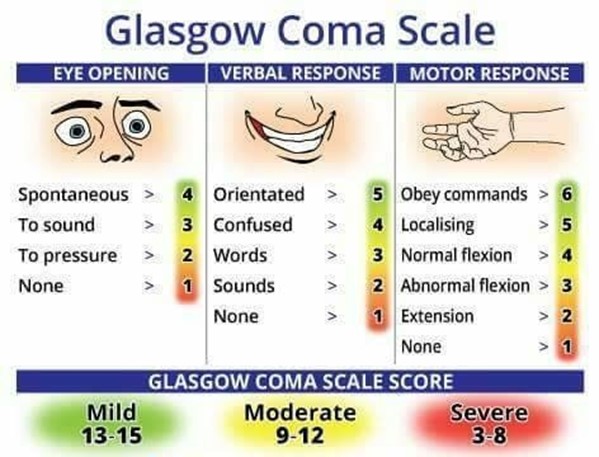A nurse in the emergency department is caring for a client who has sustained a head injury. The nurse notes the client's IV fluids are infusing at 125 mL/hr. Which of the following is an appropriate action by the nurse?
Slow the rate to 50 mL/hr.
Increase the rate to 250 mL/hr.
Slow the rate to 20 mL/hr.
Continue the rate at 125 mL/hr.
The Correct Answer is C
Choice A Reason: This choice is incorrect because slowing the rate to 50 mL/hr may not be enough to prevent cerebral edema, which is a common complication of head injury. Cerebral edema is a swelling of the brain tissue due to increased fluid accumulation. It can cause increased intracranial pressure (ICP), which can lead to brain damage or death. Therefore, the nurse should limit the fluid intake of the client with head injury to avoid worsening the condition.
Choice B Reason: This choice is incorrect because increasing the rate to 250 mL/hr may cause fluid overload, which can also increase the ICP and worsen the cerebral edema. Fluid overload is a condition in which the body has too much fluid, which can impair the function of the heart, lungs, and kidneys. Therefore, the nurse should avoid giving too much fluid to the client with head injury.
Choice C Reason: This choice is correct because slowing the rate to 20 mL/hr may help to maintain adequate hydration and electrolyte balance, while preventing fluid overload and cerebral edema. This is a conservative approach that can be used until the client's neurological status and ICP are assessed and monitored.
Choice D Reason: This choice is incorrect because continuing the rate at 125 mL/hr may not be appropriate for the client with head injury, depending on their individual needs and condition. The nurse should adjust the fluid rate according to the client's vital signs, urine output, serum osmolality, and ICP. Therefore, the nurse should not assume that this rate is optimal for the client without further evaluation.
Nursing Test Bank
Naxlex Comprehensive Predictor Exams
Related Questions
Correct Answer is D
Explanation
Choice A Reason: Cause of the burn is not the nurse's priority when assessing the severity of the client's burns. The cause of the burn may indicate the type and duration of exposure, such as thermal, chemical, electrical, or radiation, which can affect the depth and extent of injury. However, these factors are secondary to ensuring adequate oxygenation and ventilation.
Choice B Reason: Age of the client is not the nurse's priority when assessing the severity of the client's burns. The age of the client may influence the response to burn injury, such as healing time, infection risk, and fluid requirements.
However, these factors are secondary to ensuring adequate oxygenation and ventilation.
Choice C Reason: Associated medical history is not the nurse's priority when assessing the severity of the client's burns. The associated medical history may affect the outcome and prognosis of burn injury, such as pre-existing conditions, medications, or allergies. However, these factors are secondary to ensuring adequate oxygenation and ventilation.
Choice D Reason: Location of the burn is the nurse's priority when assessing the severity of the client's burns. The location of the burn can indicate the potential for life-threatening complications, such as airway obstruction, inhalation injury, or impaired circulation. The nurse should assess for signs and symptoms of respiratory distress, such as stridor, wheezes, or cyanosis, and prepare for endotracheal intubation if needed. The nurse should also monitor for signs and symptoms of compartment syndrome, such as pain, pallor, paresthesia, pulselessness, or paralysis, and report any findings to the provider. The location of the burn can also affect the functional and cosmetic outcomes, such as vision loss, facial disfigurement, or joint contractures. The nurse should provide appropriate wound care, pain management, and rehabilitation as prescribed. Assessing for location of burn is essential to prevent further injury and preserve vital functions.
Correct Answer is B
Explanation
Choice A Reason: This is incorrect because the client is not in deep coma, as the Glasgow Coma Scale (GCS) score ranges from 3 to 15, with 3 being the lowest possible score and indicating deep coma or death.
Choice B Reason: This is correct because the client needs total nursing care, as the GCS score of 6 indicates a severe brain injury and a very low level of consciousness. The client may only open his eyes to pain, make incomprehensible sounds, and have abnormal flexion to pain.
Choice C Reason: This is incorrect because the client is not alert and oriented, as the GCS score of 6 indicates a severe brain injury and a very low level of consciousness. The client may not be able to follow commands, answer questions, or recognize people or places.
Choice D Reason: This is incorrect because the client is not responding to verbal stimuli, as the GCS score of 6 indicates a severe brain injury and a very low level of consciousness. The client may only respond to painful stimuli, such as pinching or squeezing.

Whether you are a student looking to ace your exams or a practicing nurse seeking to enhance your expertise , our nursing education contents will empower you with the confidence and competence to make a difference in the lives of patients and become a respected leader in the healthcare field.
Visit Naxlex, invest in your future and unlock endless possibilities with our unparalleled nursing education contents today
Report Wrong Answer on the Current Question
Do you disagree with the answer? If yes, what is your expected answer? Explain.
Kindly be descriptive with the issue you are facing.
